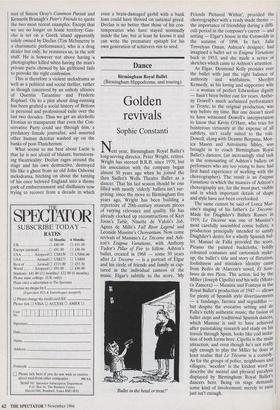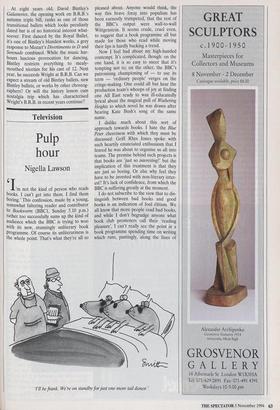Dance
Birmingham Royal Ballet (Birmingham Hippodrome, and touring)
Golden revivals
Sophie Constanti
Next year, Birmingham Royal Ballet's long-serving director, Peter Wright, retires. Wright has steered B.R.B. since 1970, but his association with the company began almost 50 years ago when he joined the then Sadler's Wells Theatre Ballet as a dancer. That his last season 'should be one filled with mostly 'elderly' ballets isn't sur- prising: since the move to Birmingham five years ago, Wright has been building a repertoire of 20th-century museum pieces of varying relevance and quality. He has already clocked up reconstructions of Kurt Jooss's Table, Ninette de Valois's Job, Agnes de Mille's Fall River Legend and Leonide Massine's Choreartiurn. Now come revivals of Massine's Le Tricome and Ash- ton's Enigma Variations, with Anthony Tudor's Pillar of Fire to follow. Ashton's ballet, created in 1968 — some 50 years after Le Tricome — is a portrait of Elgar and his circle of friends and family as cap- tured in the individual cameos of the music. Elgar's subtitle to the score, 'My `Bullet in the head or treat?' Friends Pictured Within', provided the choreographer with a ready made theme the importance of friendship during a diffi- cult period in the composer's career — and setting — Elgar's house in the Cotswolds in the autumn of 1898. In fact, Julia Trevelyan Oman, Ashton's designer, had imagined a ballet set to Enigma Variations back in 1953, and she made a series of sketches which came to Ashton's attention.
As Elgar, Desmond Kelly presides over the ballet with just the right balance of authority and wistfulness. Sherilyn Kennedy, as his loving and supportive wife — a woman of perfect Edwardian dignity — hasn't been better cast for years. Antho- ny Dowell's much acclaimed performance as Troyte, in the original production, was way before my time. But one doesn't need to have witnessed Dowell's interpretation to know that Kevin O'Hare, who tries for boisterous virtuosity at the expense of all subtlety, isn't really suited to the role. Dowell, along with Deanne Bergsma, Mon- ica Mason and Antoinette Sibley, was brought in to coach Birmingham Royal Ballet's dancers, (an increasingly vital task in the remounting of Ashton's ballets on performers who are too young to have had first hand experience of working with the choreographer). The result is an Enigma Variations in which the nuances of Ashton's choreography are, for the most part, visible and in which important details of shape and style have not been overlooked.
The same cannot be said of Lorca Mas- sine's staging of his father's Le Tricorne. Made for Diaghilev's Ballets Russes in 1919, Le Tricome was one of Massine's most carefully assembled comic ballets, a production principally intended to satisfy Diaghilev's desire for a wholly Spanish bal- let. Manuel de Falla provided the score, Picasso the painted backcloths, boldly coloured costumes and cartoonish make- up; the ballet's title and story of flirtation, foolishness and mistaken identity came from Pedro de Alarcon's novel, El Som- brero de tres Picos. The action, led by the Miller (Joseph Cipolla) and his wife (Moni- ca Zamora) — Massina and Fonteyn in the Royal Ballet's production of 1947 — allows for plenty of Spanish style divertissements — a fandango, farruca and seguidillas but despite the evocative setting and de Falla's richly authentic music, the fusion of ballet steps and traditional Spanish dances, which Massine is said to have achieved after painstaking research and study on his travels through Spain, looks like cod imita- tion of both forms here. Cipolla is the main attraction, and even though he's not really ugly enough to play the Miller he does at least realise that Le Tricome is a comedy. As for the groups of police, neighbours and villagers, 'wooden' is the kindest word to describe the mental and physical paralysis displayed by Birmingham Royal Ballet s dancers here. Being on stage demands some kind of involvement; merely to exist just isn't enough. At eight years old, David Bintley's Galanteries, the opening work on B.R.B.'s autumn triple bill, ranks as one of those transitional ballets which looks peculiarly dated but is of no historical interest what- soever. First danced by the Royal Ballet, it's one of Bintley's blandest works, a grey response to Mozart's Divertimento in D and Serenade combined. While the music har- bours luscious provocation for dancing, Bintley restricts everything to mealy- mouthed niceties for his cast of 12. Next year, he succeeds Wright at B.R.B. Can we expect a stream of old Bintley ballets, new Bintley ballets, or works by other choreog- raphers? Or will the history lesson cum nostalgia trip which has characterised Wright's B.R.B. in recent years continue?











































































 Previous page
Previous page